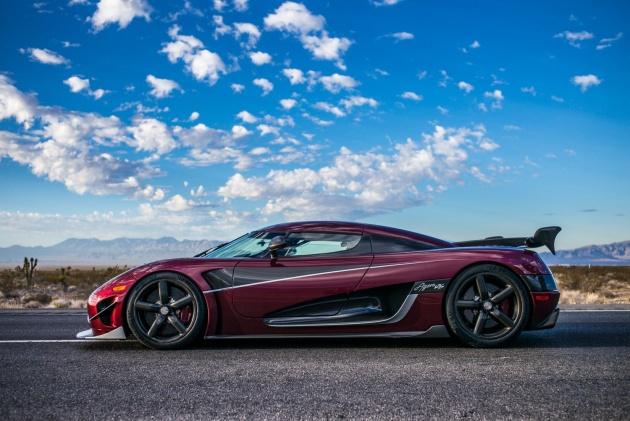A few days ago, it was revealed a Koenigsegg Agera RS managed to set a new record to become the world’s fastest production car. However, that’s not the only record that was set on that day, as Koenigsegg has since released a detailed account of the five records set on November 4, 2017.
Before that however, some disclosure: The Agera RS used is the same one that set the 0-400-0 km/h record in October 2017. It is indeed a customer-owned vehicle, but has been modified to include a roll cage for safety reasons (available as an optional extra for customers). Behind the wheel is the carmaker’s factory driver, Niklas Lilja.
The 5.0 litre twin-turbo V8 is identical to the one in One:1, and outputs 1,360 PS when E85 fuel is used. Only one set of Michelin Pilot Sport Cup 2 tyres were used during all five record attempts, fitted to Koenigsegg’s five-spoke Aircore carbon-fibre wheels.
As for the location, the high-speed runs were made on a public road, on a closed section of Highway 160 near Pahrump, Nevada, in the United States. The carmaker initially had Highway 160 booked and blocked for two days – November 4 and 5 – to set the records. Fortunately, it only took them until lunchtime on day 1 (November 4) to set all the records, so they won’t be “challenging Guy Fawkes to November 5th bragging rights.”
With that out of the way, we start with the first record set on the day – highest top speed for a production vehicle. The previous recognised record was held by the Bugatti Veyron Super Sport, which recorded a speed of 431.07 km/h (267.86 mph).
To qualify for the record books, a vehicle will need to perform runs in opposite directions. As the topography of Highway 160 is variable, the Agera RS’s north-westerly run would be slightly downhill, whereas the south-easterly run was slightly uphill with hint of headwind that affected the recorded speed.
On the Agera RS’ slightly more advantageous north-westerly run – from the Las Vegas end heading towards Pahrump – the hypercar managed to hit a top speed of 457.94 km/h (284.55 mph). On the other hand, the south-easterly run was completed with a top speed of 436.44 km/h (271.19 mph).
The average of both top speeds, recorded with Vbox data-logging equipment supplied by Racelogic, was 446.97 km/h (277.87 mph). This is good enough for a new world record, and is nearly 16 km/h or 10 mph more than what was achieved by the Veyron Super Sport.
Moving on, remember the 0-400-0 km/h record that Koenigsegg just a month ago? Well, that record has been shattered (again) as the Agera RS managed to set a new record time of 33.29 seconds, which is nearly six seconds more than what the Chiron accomplished in September, and 3.15 seconds than the carmaker’s own record set in October.
We’re at the halfway mark, and at number three, the Agera RS managed to set a new record for a flying kilometre on a public road. The previous record was set by Mercedes-Benz on January 28, 1938, with Rudolf Caracciola recording an average speed of 432.7 km/h (268 mph) in a modified version of the Mercedes W125 race car.
With runs in both directions, the Agera RS recorded a south-easterly flying kilometre average speed of 435.08 km/h (270.4 mph) and while the north-westerly flying kilometre run saw an average speed of 456 km/h (283.4 mph). The average of these two flying kilometres, completed in both directions is 445.54 km/h (276.9 mph), which is 12.84 km/h over the nearly 80-year-old record.
At number four, the Agera RS managed to achieve the highest average speed for a flying mile on a public road – 444.66 km/h (276.36 mph) – beating out the Caracciola’s flying mile speed of 432.4 km/h (268.74 mph). Once again, runs in both directions resulted in the north-westerly flying mile being completed at 454.63 km/h (282.55 mph) and the south-easterly flying mile at 434.7 km/h (270.17 mph).
Lastly, the Agera RS recorded a speed of 457.49 km/h (284.55 mph) during its north-westerley run, which the company believes is the highest ever speed achieved on a public road. The previous record was 432.7 km/h, set by the Mercedes-Benz Rekordwagen in 1938, so you’re looking at a 24.79 km/h improvement. However, the company acknowledges higher speeds may have been achieved on private tracks or salt flats, but they are unable to identify a higher speed achieved on a public road.
Source: Read Full Article





